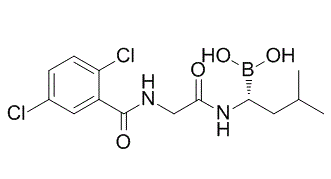| Description: |
Ixazomib (MLN2238) is a selective, potent, and reversible proteasome inhibitor, which inhibits the chymotrypsin-like proteolytic (β5) site of the 20S proteasome with an IC50 of 3.4 nM (Ki of 0.93 nM). |
| In Vivo: |
Ixazomib (MLN2238) shows antitumor activity in the CWR22 xenograft model. The antitumor effects of Ixazomib (MLN2238) dosed at 14 mg/kg i.v. or 7 mg/kg i.v. are compared with Bortezomib dosed at 0.8 mg/kg i.v. or 0.4 mg/kg i.v. on a twice weekly regimen. The high dose for both Ixazomib (MLN2238) and Bortezomib shows similar antitumor activity in this model (T/C=0.36 and 0.44, respectively). However, Ixazomib (MLN2238) (7 mg/kg) shows greater efficacy at a 0.5 MTD dose compared with a 0.5 MTD dose of Bortezomib (0.4 mg/kg; T/C=0.49 compared with T/C=0.79, respectively) Ixazomib (MLN2238) shows time-dependent reversible proteasome inhibition; however, the proteasome dissociation half-life (t1/2) for Ixazomib (MLN2238) is determined to be 18 minutes[1]. |
| In Vitro: |
Ixazomib (MLN2238) is an N-capped dipeptidyl leucine boronic acid and preferentially bound to and inhibited the chymotrypsin-like proteolytic (β5) site of the 20S proteasome with an IC50 value of 3.4 nM (Ki of 0.93 nM). At higher concentrations, Ixazomib (MLN2238) also inhibits the caspase-like (β1) and trypsin-like (β2) proteolytic sites (IC50 of 31 and 3,500 nM, respectively). Cell viability studies are performed in a variety of mammalian cell lines to compare the in vitro antiproliferative effects of Ixazomib (MLN2238) with Bortezomib. Studies performed with A375 (lung), H460 (lung), HCT-116 (colon), and HT-29 (colon) cells revealed similar LD50 values for the two compounds, which range from 4 to 58 nM[1]. |






















